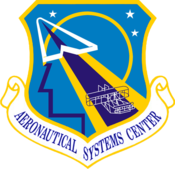Aeronautical Systems Division
| Aeronautical Systems Center | |
|---|---|
| Active | 1961–2012 |
| Country | United States |
| Branch | United States Air Force |
| Role | Equipment procurement and sustainment |
| Insignia | |
| Aeronautical Systems Center emblem |  |
The Aeronautical Systems Center (ASC) is an inactivated Air Force product center that designed, developed and delivered dominant aerospace weapon systems and capabilities for U.S. Air Force, other U.S. military, allied and coalition-partner warfighters, in support of Air Force leadership priorities. ASC managed 420 Air Force, joint and international aircraft acquisition programs and related projects; executed an annual budget of $19 billion and employed a work force of more than 11,000 people, located at Wright-Patterson Air Force base and 38 other locations worldwide. The center was organized into wings, groups, and squadrons designed to foster synergy in the acquisition process and speed delivery of war-winning capabilities. ASC's portfolio included capabilities in fighter/attack, long-range strike, reconnaissance, mobility, agile combat support, special operations forces, training, unmanned aircraft systems, human systems integration and installation support. ASC was inactivated during a July 20, 2012 ceremony held at Wright-Patterson Air Force Base, Ohio.
The Airplane Engineering Department, precursor of ASC, was first established under the U.S. Army's Aviation Section, U.S. Signal Corps in late 1917 at McCook Field. Early on the department's focus was flight testing and training. The department was renamed the Airplane Engineering Division following World War I, it continued its mission of flight testing and training, but also began development and engineering. One early native model, the VCP-1 was designed by resident engineers, Alfred V. Verville and Virginius E. Clark. Another aircraft tested was the MB-1, eventually used as the standard mail plane. The division also expanded operations to Wilbur Wright Field. The division also pioneered aviation safety with the use of free-fall parachutes and the development of protective clothing, closed cockpits, heated and pressurized cabins, and oxygen systems. As the stockpile of aircraft and parts grew the division was able to spend more time finding ways to enhance tools and procedures for pilots. Advancements include things like an electric ignition system, anti-knock fuels, navigational aids, improved weather forecasting techniques, stronger propellers, advancements in aerial photography, and the design of landing and wing lights for night flying.
...
Wikipedia
